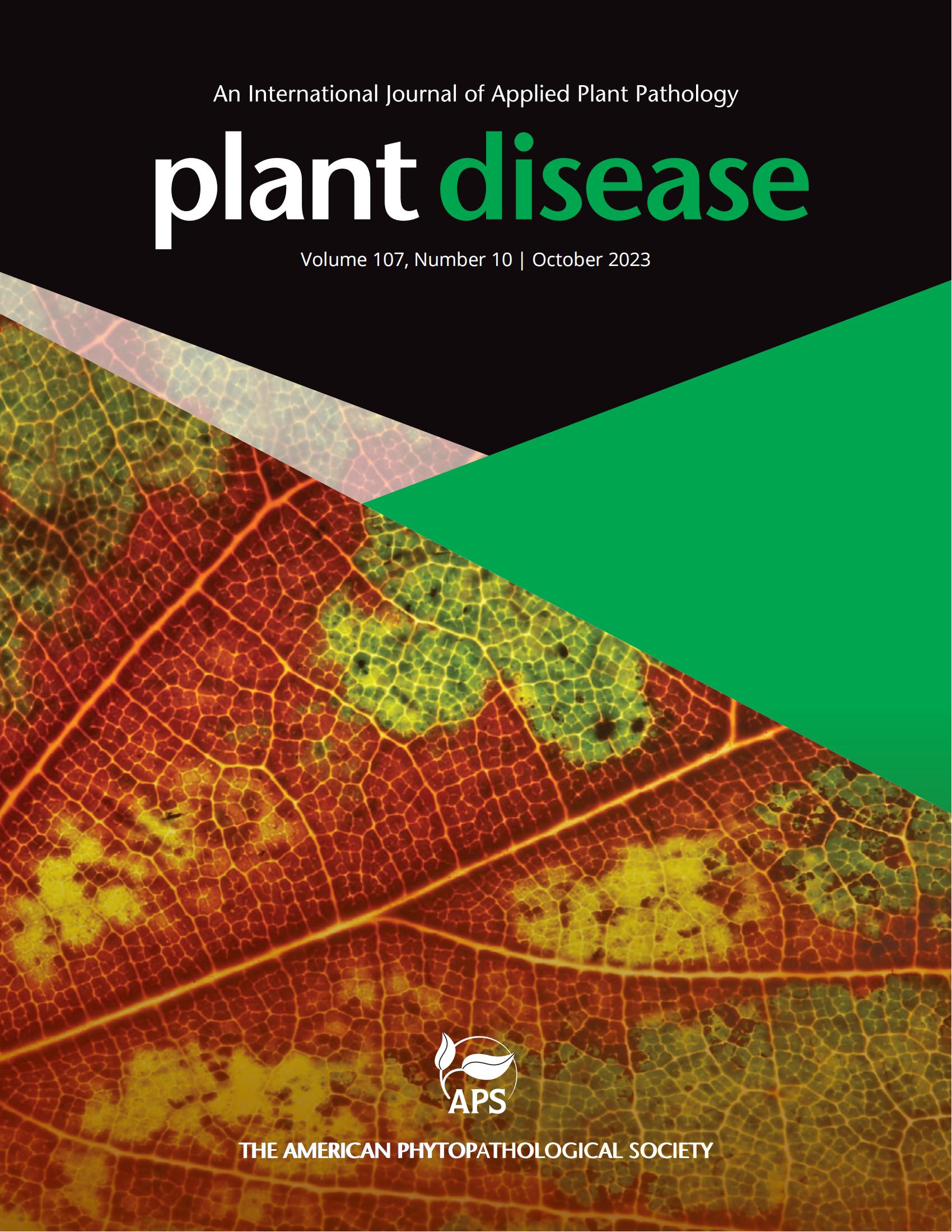中国泽泻(Alisma plantosphaerella alismatis)引起的斑叶病首次报道。
摘要
泽泻(Alisma Plantago-Aquatica Linn.)是中国传统的药用水生植物。自2024年8月以来,在中国四川省雅安市玉城区(北纬29°98′,东经102°98′)发现了泽泻斑叶病,田间平均发病率为70% ~ 90%。首先在外层叶片上观察到圆形的红棕色斑点,然后较大的斑点合并,导致叶片变黄和死亡,最终导致产量损失约35%。为分离病原微生物,收集10份有症状的叶片样品,75%乙醇消毒30 s, 0.5% NaClO消毒2 min,无菌水冲洗3次后,转移到添加50 mg L-1硫酸链霉素的马铃薯葡萄糖琼脂(PDA)培养基中,28℃暗室培养。7天后,将新生菌落的菌丝尖端转移到新鲜的PDA上进行纯化。得到的8株分离株命名为ZX1 ~ ZX8。我们初步测试了分离菌株在离体叶片上的致病性。将分离的5 mm PDA琼脂块接种于健康离体叶片上,空白PDA琼脂为对照。7 d后,只有接种ZX6的叶片出现了与田间相似的斑点和黄变症状。与其他菌株和对照接种的叶片无症状。因此,我们进一步测试了ZX6对整株植物的致病性。以ZX6孢子悬浮液(106孢子/ml)接种健康泽泻幼苗(2月龄),清水为对照。植株在生长室(22-28°C, 85%相对湿度,光照16 h,黑暗8 h)中培养。重复2次致病性试验。接种7 d后,叶片出现典型的叶斑病症状。根据科赫的要求,从受感染的叶片中重新分离出的病原体显示出与最初分离的ZX6相同的形态特征。说明ZX6是泽泻斑叶病的病原菌。ZX6菌落在PDA上最初是白色和蓬松的,逐渐变成橙红色,很少有空气菌丝和粘稠的表面。分生孢子光滑,间隔0 ~ 1,椭圆形或卵圆形,直径12.2 ~ 19.4 × 2.2 ~ 3.4µm(平均15.5 × 2.7µm, n=100)。这些形态特征与Plectosphaerella spp. (Carlucci et al. 2012;Pitt et al. 2005)。为了进行物种鉴定,我们提取了菌丝体基因组DNA,并分别使用引物对ITS1/ITS4 (White et al. 1990)、LR0R/LR5 (Hopple et al. 1999)和CL1/CL2 (Weir et al. 2012)进行了内部转录间隔段(ITS)、rDNA大亚基(LSU)和钙调素(CaM)基因的扩增。BLAST检索结果显示,ITS、LSU和CaM序列与NCBI数据库(检索号分别为JF780523、KY662261和KY416925)中的alismatiplectosphaerella alismatis菌株CBS 113362的相似性分别为99.39% (492 / 495 bp)、100% (850 / 850 bp)和100% (479 / 479 bp)。基于ITS、LSU和CaM组合序列,利用MEGA 11.0构建了最大似然系统发育树。结合形态特征和系统发育分析,确定分离物ZX6为泽马假体(P. alismatis)。本研究首次报道了车前草泽马感染泽马病的情况。中国的树叶。该结果将有助于制定有效的泽泻斑病防治措施。Alisma (Alisma Plantago-Aquatica Linn.) is a traditional medicinal aquatic plant in China. Since August 2024, a leaf spotting disease of Alisma, with an average incidence of 70% ~ 90% across fields, has been observed in Yucheng District, Ya`an City, Sichuan Province, China (29°98'N and 102°98'E). The round red-brown spots were first observed on the outer leaves, and then the larger spots merged, resulting in leaf yellowing and death, ultimately leading to approximately 35% yield loss. To isolate pathogenic microorganisms, ten symptomatic leaf samples were collected and disinfected with 75% ethanol for 30 s, followed by 0.5% NaClO for 2 min. After rinsing three times with sterile water, the samples were transferred to potato dextrose agar (PDA) medium supplemented with 50 mg L-1 streptomycin sulfate, and cultured in the dark at 28°C. After 7 days, the hyphal tips of the emerging colonies were transferred to fresh PDA for purification. The eight isolates obtained were named ZX1 to ZX8. We initially tested the isolates' pathogenicity on detached leaves. 5 mm PDA agar blocks of the isolates were inoculated onto healthy detached leaves, with blank PDA agar as the control. After 7 days, only the leaves inoculated with ZX6 showed spots and yellowing symptoms similar to those observed in the field. The leaves inoculated with other isolates and the control showed no symptoms. Consequently, we further tested the pathogenicity of ZX6 on whole plants. Healthy Alisma seedlings (2-month-old) were inoculated with ZX6 conidial suspension (106 spores/ml) and with clean water as the control. Plants were incubated in a growth chamber (22-28°C, 85% relative humidity, 16 h light and 8 h dark). The pathogenicity test was repeated twice. Typical leaf spot symptoms were observed on the inoculated leaves after 7 days. The pathogens, reisolated from infected leaves, displayed the same morphological traits as the initial isolates ZX6, according to Koch's requirements. This result indicated that ZX6 is the pathogen leading to leaf spotting disease on Alisma. Colonies of ZX6 were initially white and fluffy on PDA, and gradually turned salmon pink, with few aerial hyphae and slimy surfaces. Conidia were smooth, with 0-1 septa, elliptical or ovoid, measuring 12.2 ~ 19.4 × 2.2 ~ 3.4 µm (average 15.5 × 2.7 µm, n=100). These morphological characteristics were similar to Plectosphaerella spp. (Carlucci et al. 2012; Pitt et al. 2005). For species identification, we extracted mycelium genomic DNA and performed amplification of the internal transcribed spacer (ITS), large subunit of rDNA (LSU), and calmodulin (CaM) genes using primer pairs ITS1/ITS4 (White et al. 1990), LR0R/LR5 (Hopple et al. 1999), and CL1/CL2 (Weir et al. 2012), respectively. In a BLAST search, the ITS, LSU, and CaM sequences showed 99.39% (492 / 495 bp), 100% (850 / 850 bp), and 100% (479 / 479 bp) similarity to Plectosphaerella alismatis strain CBS 113362 in the NCBI database (accession numbers JF780523, KY662261, and KY416925, respectively). Based on the combined ITS, LSU, and CaM sequences, a maximum likelihood phylogenetic tree was constructed using MEGA 11.0. By combining morphological characteristics and phylogenetic analysis, the isolate ZX6 was confirmed as P. alismatis. Our study is the first report describing P. alismatis infection of Alisma plantago-aquatica Linn. leaves in China. This result will contribute to developing effective measures to control the leaf spotting disease of Alisma.

 求助内容:
求助内容: 应助结果提醒方式:
应助结果提醒方式:


